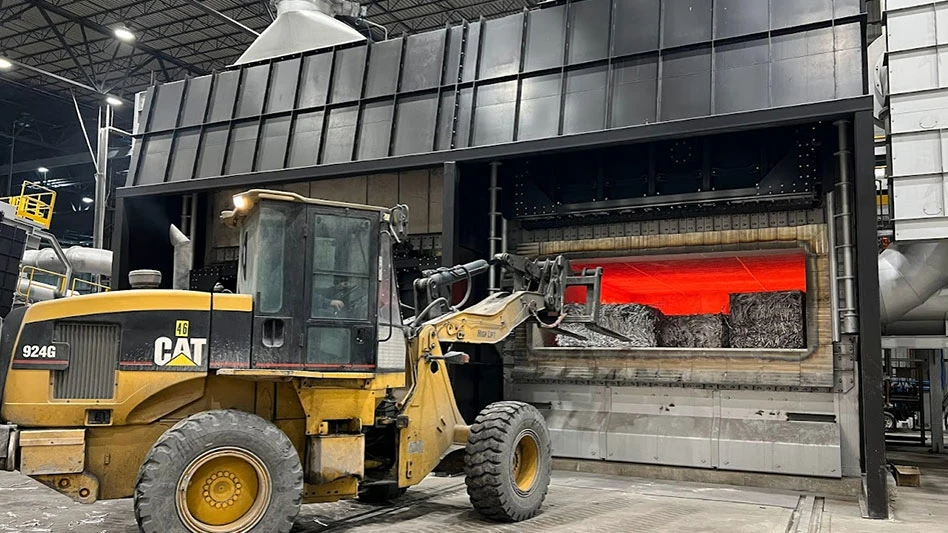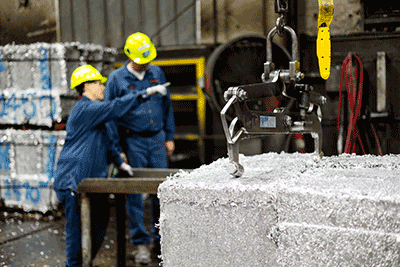
Photo courtesy of Gränges Americas
Gränges Americas Inc. has been investing in its operations with the goal of lowering its carbon footprint (and that of its customers) by investing in technology to increase its use of recycled aluminum as well as renewable energy.
In 2021, the company announced it would install an aluminum caster dedicated to recycled material at its Huntingdon, Tennessee, operations. That caster started up in early 2023. Additionally, this year, Rosa Laxamana, vice president of sustainability at Gränges Americas Inc., says the company will increase using renewable energy in its operations, including powering another new caster in late 2024.
Gränges, headquartered in Stockholm, has six facilities on three continents that produce rolled aluminum for use in automotive HVAC, electrification and battery components, packaging and more with a combined annual production capacity of 610,000 metric tons. In addition to the Gränges Americas sites in Huntingdon; Salisbury, North Carolina, and Newport, Arkansas, Gränges has operations in Shanghai; Finspång, Sweden; and Konin, Poland.

reduce its carbon emissions.
“The global goals of the company are to increase the recycled volume by 10 times versus the 2017 baseline and, so far, we are above 40 percent sourced recycled content as a group, and in the Americas region we are over 60 percent sourced recycled content for our materials, which is industry-leading,” Laxamana says.
Gränges Europe’s total production capacity for flat-rolled aluminum products totals 260,000 metric tons annually (120,000 metric tons in Finspång and 140,000 metric tons in Konin). This region serves customers in the automotive, building and construction and packaging business, producing 1000, 3000, 4000, 5000 and 8000 series aluminum using a direct chill casting method in its remelting facilities. The product segments the company serves include heat exchanger materials, building sheet materials, battery casing materials, battery foil materials and common alloys for business in Europe and the Americas.
Gränges Asia’s Shanghai operations serve the heat exchanger and electric vehicle (e.g., battery plate) industry in China and Asia more broadly with an annual production capacity of 120,000 metric tons.
Priority investments
Gränges Americas Inc., headquartered in Franklin, Tennessee, is investing across its operations to capitalize on new market opportunities and to increase the sustainability of its operations.
The company says it invested $33 million in its new recycling and casting line in Huntingdon, which has been designed to increase its capacity, provide sustainable alloys and support Gränges’ ambitious sustainability goals by increasing renewable energy and decreasing carbon emission intensity.
Gränges Americas Inc. also announced an additional investment of $52 million in Huntingdon, enabling its launch of near-zero-carbon aluminum solutions later this year to meet growing demand for sustainable products in North America. The new center will be powered via renewable electricity sourced from a solar field built in Tennessee through the Tennessee Valley Authority (TVA).
The company says the investment will lead to a reduced carbon footprint driven by using renewable electricity, eliminating natural gas and using only recycled material.
When the investment was announced in April of 2022, Jörgen Rosengren, president and CEO of Gränges Group, said, “Sustainability and recycling are two critical parts of our business model and strong drivers of our long-term competitiveness and value creation. We have a very high ambition level in these areas. With this investment, we will meet our customers’ expectations on decarbonizing our business and leading the way in offering solutions that are clearly differentiated from a sustainability perspective.”
Laxamana says the Huntingdon facility is the largest that Gränges operates in the U.S., all of which are cold-rolling facilities producing unclad, thin-gauge aluminum foil that can be used in many different niche applications, including the packaging industry, automotive, building and construction and HVAC.
“The average share of recycled content in the coils of aluminum Gränges Americas produces has grown from 30 percent in the last decade to 63 percent at the end of 2023,” she says.
Carbon reductions sought
Among the products Gränges Americas produces are household foil, disposable pans and to-go containers. “Many of these have upwards of 95 to 98 percent recycled content within the product and a very low carbon footprint,” Laxamana says.
Gränges Americas consumes includes external scrap that it purchases, internally generated material and scrap returned from its customers, with many of the company’s largest customers participating in closed-loop programs.
For the external scrap it purchases, “We have several scrap suppliers that we purchase from,” she says, in addition to buying recycled aluminum ingots.
“All of those different types of scrap are about 63 percent of our total metal inputs, and, in addition, this year we have started to purchase low-carbon primary [aluminum].”
Through its use of scrap, since 2017 Gränges America has been able to reduce its carbon emissions from 9 tons per ton of aluminum shipped to its customers to less than 5 tons, Laxamana says, which is good news for its customers that are looking to decarbonize their supply chains upstream.
In terms of its own sustainability goals, Gränges has set the goal to reduce its absolute Scope 1 and 2 greenhouse gas (GHG) emissions by 42 percent by 2030 from the 2021 baseline year and its Scope 3 GHG emissions (which are from purchased goods and services, including metal purchases, fuel- and energy-related activities, upstream transportation and distribution, business travel and downstream transportation and distribution) by 57 percent per ton of packed product. The Science Based Targets initiative (SBTi) has validated Gränges’ climate goals for near-term 2030 and net-zero 2040, meaning they are aligned with the latest climate science and consistent with the goals of the Paris Agreement and that Gränges is committed to driving emission reductions in line with science.
At its Newport site, the company will transition to using solar energy instead of natural gas to power its ovens, Laxamana says. “That’s the Scope 2 portion of what we’re trying to do to reduce that footprint as well.”
Gränges Americas’ use of renewable energy will help the company to meet these targets. However, until the company can obtain all the renewable energy it needs, Laxamana says it is bridging the gap by purchasing renewable energy credits where available.
She continues, “We’ve made huge impacts reducing our own carbon footprint because we know the importance that plays downstream to the customer, all the way to the consumer.”
Laxamana says Gränges Americas tries to educate its consumers on the carbon footprint of the aluminum it is producing and selling. “Customers who might go overseas to buy aluminum because they can get it much cheaper also must understand that the carbon footprint is almost four times greater than what it is in the U.S.”
To increase the transparency of its products, she says the company is providing customers with third-party-certified carbon footprint certificates.
Laxamana adds that once customers realize they have carbon-reduction goals and the aluminum they purchase is part of their Scope 3 emissions, “then the light bulbs go on,” and they understand the benefits of sourcing from Gränges.
Latest from Recycling Today
- BMW Group, Encory launch 'direct recycling’ of batteries
- Loom Carbon, RTI International partner to scale textile recycling technology
- Goodwill Industries of West Michigan, American Glass Mosaics partner to divert glass from landfill
- CARI forms federal advocacy partnership
- Monthly packaging papers shipments down in November
- STEEL Act aims to enhance trade enforcement to prevent dumping of steel in the US
- San Francisco schools introduce compostable lunch trays
- Aduro graduates from Shell GameChanger program





